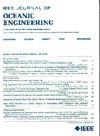Expansion of Field of View for Near-Field Fast Beamforming in 3-D Acoustic Imaging Based on the Optimized Subregion Approach
IF 3.8
2区 工程技术
Q1 ENGINEERING, CIVIL
引用次数: 0
Abstract
Real-time underwater 3-D acoustic imaging employs various fast-beamforming methods that significantly reduce the computational cost. However, in the near-field region, these methods rely on a popular model based on the Fresnel approximation, which has a narrow field of view (FOV) boundary of approximately基于优化子区域方法的三维声成像近场快速波束形成视场扩展
实时水下三维声成像采用多种快速波束形成方法,大大降低了计算成本。然而,在近场区域,这些方法依赖于基于菲涅耳近似的流行模型,该模型的视场(FOV)边界约为$26^\circ$。与远场相比,近场的视场非常有限。因此,本研究提出了一种优化子区域方法,消除快速波束形成的视场限制,提高近场区域的视场。首先,将视场划分为子区域,在每个子区域内采用线性逼近简化时延表达式,并将逼近误差限制在合理的阈值内;利用最小二乘法和坐标旋转技术,对每个子区域的视场进行了理想形状的重构。随后,提出了一种嵌套的非均匀快速傅里叶变换来实现快速波束形成,并且可以并行计算子区域。结果表明,该方法克服了三维声成像中近场快速波束形成的视场限制,计算复杂度与现有算法相当。此外,该方法支持不规则平面阵列,并保持了令人满意的性能。
本文章由计算机程序翻译,如有差异,请以英文原文为准。
求助全文
约1分钟内获得全文
求助全文
来源期刊

IEEE Journal of Oceanic Engineering
工程技术-工程:大洋
CiteScore
9.60
自引率
12.20%
发文量
86
审稿时长
12 months
期刊介绍:
The IEEE Journal of Oceanic Engineering (ISSN 0364-9059) is the online-only quarterly publication of the IEEE Oceanic Engineering Society (IEEE OES). The scope of the Journal is the field of interest of the IEEE OES, which encompasses all aspects of science, engineering, and technology that address research, development, and operations pertaining to all bodies of water. This includes the creation of new capabilities and technologies from concept design through prototypes, testing, and operational systems to sense, explore, understand, develop, use, and responsibly manage natural resources.
 求助内容:
求助内容: 应助结果提醒方式:
应助结果提醒方式:


